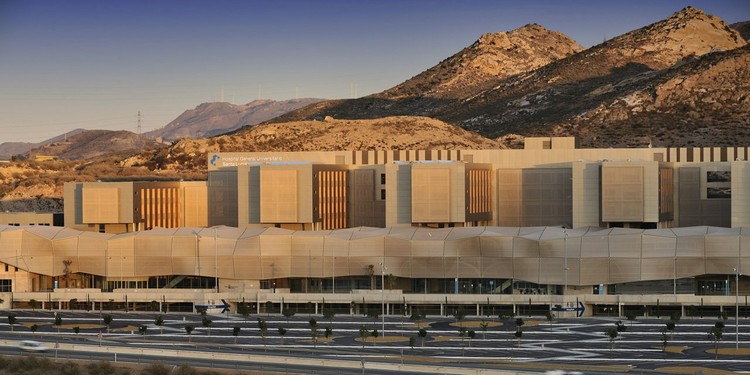
-
Architects: CASA sólo arquitectos
- Area: 114369 m²
- Year: 2003
-
Manufacturers: Alucoil

Text description provided by the architects. The new university hospital of Santa Lucía proposes a new hospital concept in which programs of sports, commercial activities, and leisure are integrated into the building to incorporate the city and its people into the hospital by developing a community health concept. This new project in Cartagena (Murcia), has a capacity of 630 beds, with all the services of a hospital of this level.


The longitudinal north-south axis of the building, parallel to the highway, organizes the spine of the rooms, orienting them to the south with views of the port and the city. The hospitalization units are located on a walkable roof in the form of a two-level terrace garden. In addition to being used by some general support units, this terrace contains new programs related to health and leisure. The general access boulevard is a non-air-conditioned covered space of transition between exterior and interior, which clarifies the position of the information and reception areas. The boulevard and open public spaces are covered by a skin of tensile textile mesh, on a metallic tubular structure, which acts as sun protection and gives the new hospital a unique identity. The organic shape of this mesh and its chromatic tones establish a semantic with the mountains of the landscape context.



Rooms. The patient rooms are unconventional. They have the bathroom located on the façade, freeing the side next to the circulation corridor and allowing the nursing staff to see the patients. This arrangement leaves a space next to the window for domestic use by both patients, in addition to allowing natural ventilation in the bathroom.

Courtyards. The treatment and arrival of natural light to the various services is an element of the utmost importance in a type of building such as the one proposed. This is achieved through a system of courtyards embedded in the structural mesh. These courtyards are large enough to be used not only as sources of natural light but also as outdoor areas for staff or patients.

Accesses. Two parallel circulations, on each side of the main block, make it possible to differentiate the accesses for visitors and outpatients, from others with less mobility who attend treatment at the hospital by means of medical transport. On the rear façade, a linear block contains general support units of a more logistical type. The staff locker rooms are located in a transition area between the staff entrances and the work areas.


Circulations. Six vertical communication cores for the public link the boulevard directly with the general hospitalization units, which can be reached without interfering with their internal circulations. These elevators can also be used to reach the technical-assistance units, the ICU on the first floor, the cafeteria, and the green floor with its leisure-health-commerce spaces.

Installations. Below the terrace garden, there is a technical floor with a free height of 2.20m for the installation of most of the building's air conditioners and other technical elements. They can receive outdoor air from their courtyards and expel it to the floating terrace areas or to other courtyards or exterior facades. This makes maintenance tasks and possible subsequent modifications of the system as easy as possible.
























